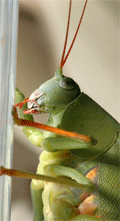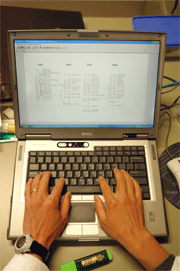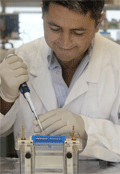Genetics - More Information
Genetics and Bioinformatics: what's behind the terms?
Genetics is a field of research where a number of different investigative approaches are applied to determine the basis of heredity; that is, how traits are passed on from parents to offspring; and the variation in the way these traits are differently expressed between individuals or populations of individuals.
In more recent times our substantive understanding of the molecular basis of heredity and gene expression and the increased application of high throughput and microchip technologies requiring new computer based approaches to research, data storage and analysis, has broadened the scope of the field of genetics research into a dynamic, multidisciplinary approach to scientific discovery. Where once we would have investigated the inheritance and expression patterns of a single or few genes we now have access to whole genome sequence databases and can investiage the expression of 1000's of genes simultaneously. The opportunities for characterisation and analysis of the genetic data that has been generated by these high throughput technologies has given rise to the whole new field of bioinformatics. The tools of bioinformatics are allowing us to find exciting new ways to investigate and manage all of life's genetic resources.
Literally there is "something for everyone" in the field of genetics because genetics research ranges from pure research, where you might investigate the molecuar basis of a disease or conservation studies of plants or animals, to highly applied areas that require highly developed skills in maths and computer programming.
Different observational approaches have led to a number of fields in genetic investigation including molecular genetics, bioinformatics, population genetics and quantitative genetics. These areas of research require different skills.
Population genetics

Population genetics is used to determine genetic diversity among groups of organisms as well as changes in gene frequencies over time and between geographical regions leading to the definition of population structure and subdivision.
Population genetics can be tied in with studies in ecology, molecular biology or quantitative genetics. For example, population genetic methodologies are used to assess the genetic diversity and population structure and relationships present in our natural flora and fauna resource bases.
Applied areas of population genetics include evolutionary genetics, conservation genetics and medical genetics.
If you combine population genetics with some ecology studies or evolutionary/systematics studies and biochemistry you can have a mixture of field, laboratory and computer based research as part of your scientific career.
Quantitative genetics

Quantitative genetics is a highly specialised form of population genetics. The focus of interest here lies with measurable performance traits within a specific environment and is most accurate when the relatedness of individuals in a population is known. Performance traits include things like height, growth rates, immunity to particular diseases, fertility, fecundity, yield etc.
Quantitative traits are often influenced by many genetic factors, with each one of these factors having only a very small effect on its own. Quantitative analysis tools can be used to detect these small effects, without even knowing the individual genes that are involved.
Now that the entire DNA sequence of many organisms such as humans, mice, pigs, cows, nematodes, bacteria, viruses etc are known, quantitative geneticists can include this molecular information in their analyses. This is leading to new ways to identify the specific genes and cellular biochemical pathways underlying many quantitative traits.
Quantitative genetics is an area of applied mathematics. Therefore, the same analytical techniques can be applied to other problems outside the field of genetics, for example pharmaceutical research.
Molecular genetics

Molecular genetics, in contrast to quantitative genetics, does concern itself with the characterisation of specific genes whether that be the structure, expression or evolutionary history of those genes. Molecular genetics is related to molecular biology. Both involve laboratory based research. Molecular biology looks at the molecular mechanisms underlying all aspects of cell function in an organism whereas molecular genetics focuses on the structure, function and evolution of DNA and RNA in particular.
If a trait is mostly or solely governed by one gene, then understanding the underlying genetic mechanism might, for example, lead to the design of a genetic test to eliminate an undesirable condition.
Bioinformatics

Bioinformatics is a growing field in genetics research where the tools of information technology are being applied to store, manipulate, interrelate and analyse the masses of data being generated by large scale projects and experiments. Examples of this type of data include whole genome sequencing data, or the gene expression data generated in microarray experiments.
Pure bioinformatics is a computational field, but a general understanding of bioinformatics is useful in all fields of biological research as new ways of designing experiments can be developed using the predictive ability available through bioinformatics.

